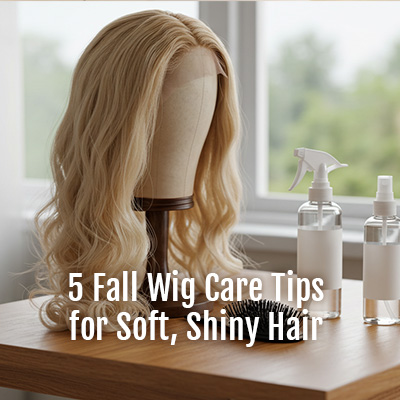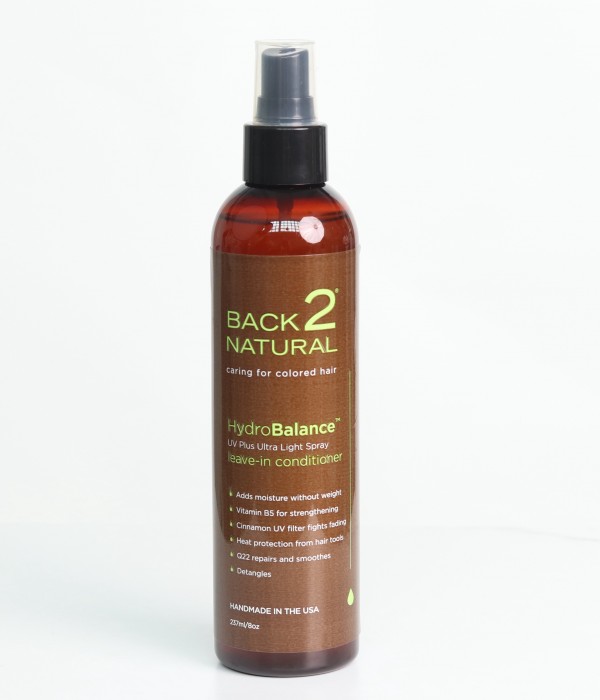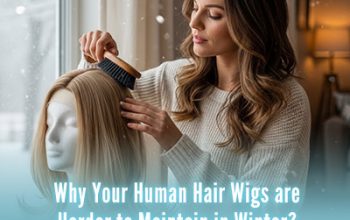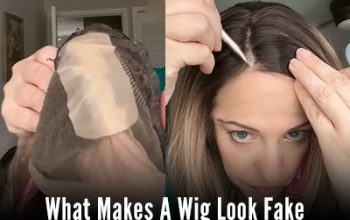
Let’s talk about fall for a second. It’s beautiful, yes, but it’s also kind of confusing. One day the sun’s out like it’s July, the next morning it feels like you’ve stepped into a wind tunnel. Your sweaters finally see daylight, pumpkin spice shows up everywhere, and somehow your hairpiece starts having attitude.
I don’t know about you, but my first cool morning each year usually comes with a battle – me versus static. I’ll leave the house thinking, “Okay, nailed it,” and by lunchtime, it looks like my wig has developed its own personality. After a few seasons of trial and error (and some tragic selfies), I’ve learned that fall hair care isn’t complicated – it just needs consistency.
Here’s everything that actually works to keep your hairpiece soft, shiny, and ready for any “crisp air and cozy scarf” kind of day.

Why Fall Messes with Your Wig More Than You Think
Here’s the deal: fall weather doesn’t like predictability. Dry air creates static, cooler winds make fibers brittle, and your favorite scarves rub against your strands. Even the collar of your jacket can flatten or frizz your style.
If you wear human hair wigs, you might notice extra shedding around this time – it’s totally normal but annoying, right? Think of it as seasonal adjustment, not disaster. Just like skin gets drier in fall, your wig needs extra hydration and care.
Giving it five minutes of attention a day keeps everything smoother, shinier, and less… chaotic. Trust me, prevention beats panic brushing any day.
Step 1: Wash Smart, Not Hard
I used to dread washing my wigs – now I kind of enjoy it. It’s like giving it a mini spa day. Use a shampoo made just for wigs (the regular stuff is too harsh). Look for “sulfate-free,” “pH balanced,” and “moisture rich” on the label.
My little ritual goes like this:
Gently detangle the strands with a wide-tooth comb. No tugging!
Fill a basin with lukewarm water – not hot, ever.
Add a bit of wig shampoo and swirl gently, like you’re washing silk.
Let it soak for a few minutes, then rinse in the same direction as the hair.
Apply a wig-friendly conditioner, especially on the ends. Rinse again.
Then I pat it dry with a soft towel (never wring it!) and let it air dry on a stand. Sometimes I’ll mist a bit of leave-in spray – it gives that light shine that says, “Yes, my hair just naturally looks this good.”
Doing this regularly keeps the strands soft, prevents weird smells, and seriously extends the life of your wig.
Step 2: Style with a Fall Mindset
Fall is perfect for low-stress styles. Skip the straightener when you can – the air’s already dry enough. Heat-free curls, loose braids, or soft twists work wonders. I love wrapping mine into a relaxed bun on lazy days, or a half-up style that fits perfectly under a beanie. — especially with wigs with bangs, which frame the face beautifully and stay neat even on windy days.
Here’s the fun part – accessories! Earthy headbands, velvet scrunchies, silk scarves… all those small touches make your look pop while protecting your wig. I even have a forest-green beret that somehow makes every outfit feel “put together.”
If you wear wig caps, go for silk or satin – they cut down friction and protect your natural hair underneath. Little details, big difference.

Step 3: Beat the Frizz Before It Starts
If I had a dollar for every time the wind made my wig go wild, I’d probably own ten new ones by now. The trick is to get ahead of it. A small bottle of leave-in conditioner or anti-static spray in your bag can save the day.
Brush gently – always from ends to roots. Break big tangles into small sections instead of fighting one big knot (your patience will thank you). And if static’s out of control? Here’s a weird but brilliant trick: rub a dryer sheet gently over your wig. Instant fix.
Sleeping habits matter too. I switched to a satin pillowcase last year – best decision ever. My morning tangles cut in half, and my hairpiece still looks smooth even after tossing all night.

Step 4: Store It Like You Care
I used to leave my wigs wherever – over chairs, on hangers, once even on a lamp (don’t ask). Then I found out that keeping it properly stored does matter. Sit it on a wig stand or head mannequin so it doesn’t lose its shape. Put a silk or satin cover over it to prevent dust, and stash it away in a cool, dry corner.
If you alternate between a couple of wigs, label them and allow each of them some downtime. And before putting one on, simply shake it up quickly and check that it is not knotted. It’s a tiny habit that streamlines mornings considerably.

Step 5: Human Hairpieces Need Extra Love
If you wear human hair, think of it like actual hair – it gets tired too. Once a week, treat it to deep conditioning. Avoid blasting it with heat tools, and protect the color with UV spray if it’s dyed. I started doing that last fall, and my wig color didn’t fade at all this year.
Bonus Reality Check
Here’s the thing: no wig (or hairpiece, or topper, or whatever you call it) is perfect every day. Some mornings, it’ll frizz anyway. Sometimes the static wins. And that’s fine. You shake it out, take a breath, maybe throw on a hat – and move on.
Hairpieces are supposed to make life easier, not stressful. Once you stop chasing perfection, the whole thing feels lighter – and ironically, your wig looks better when you’re relaxed.
Final Thoughts: Cozy Season, Great Hair Days
Autumn is all about warmth, comfort, and change – your hairpiece can fit right into that rhythm. With gentle washing, protective styling, moisture care, and a smart storage setup, you’ll sail through the season looking put-together and confident.
So go ahead: grab that latte, toss on your scarf, and step into the crisp air knowing your hairpiece – maybe one of those soft, brown wigs that echo the fall leaves – has your back. Even if the leaves are falling, your style doesn’t have to.
Here’s to soft strands, golden days, and that unbeatable “good hair” feeling – no matter what the wind says.


